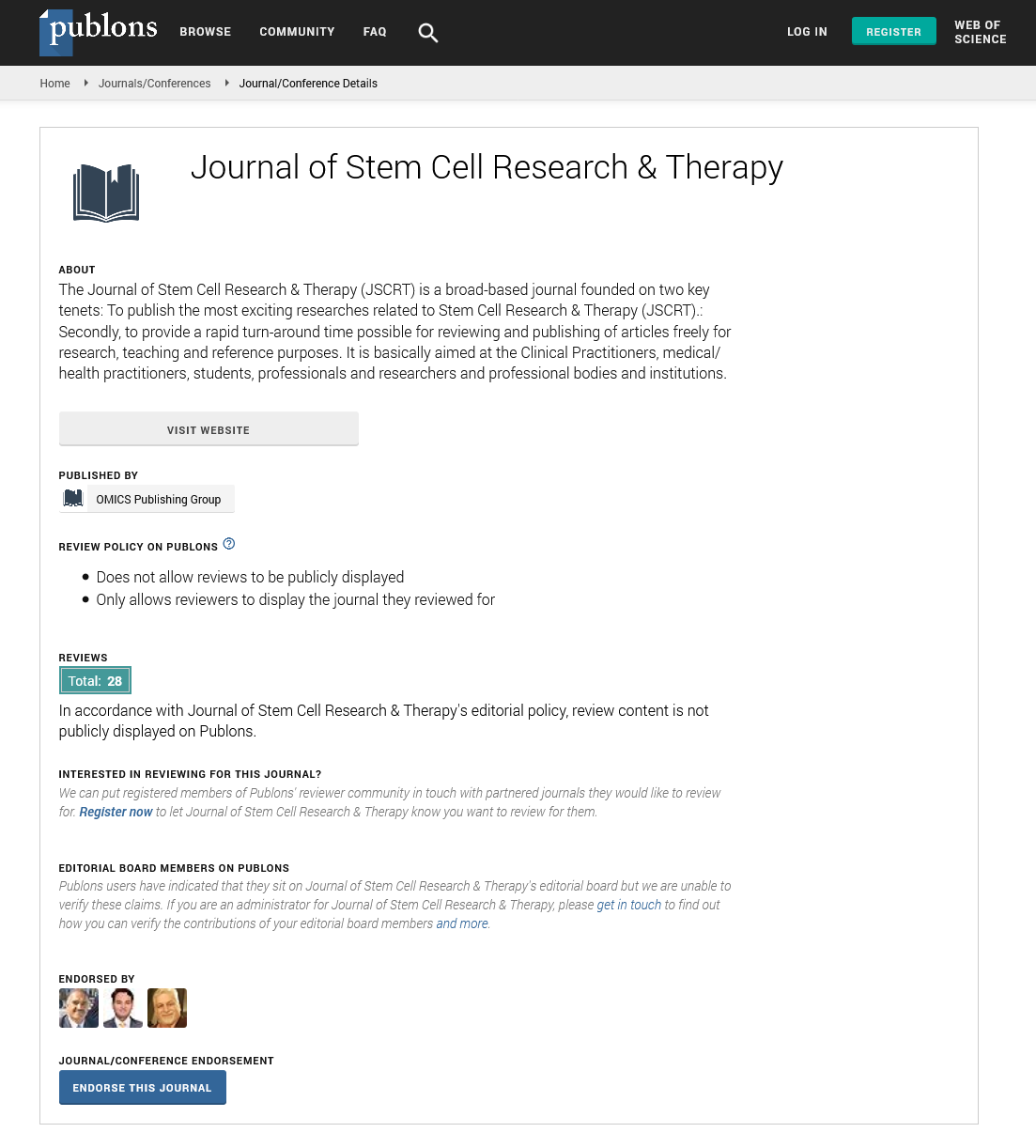Indexed In
- Open J Gate
- Genamics JournalSeek
- Academic Keys
- JournalTOCs
- China National Knowledge Infrastructure (CNKI)
- Ulrich's Periodicals Directory
- RefSeek
- Hamdard University
- EBSCO A-Z
- Directory of Abstract Indexing for Journals
- OCLC- WorldCat
- Publons
- Geneva Foundation for Medical Education and Research
- Euro Pub
- Google Scholar
Useful Links
Share This Page
Journal Flyer

Open Access Journals
- Agri and Aquaculture
- Biochemistry
- Bioinformatics & Systems Biology
- Business & Management
- Chemistry
- Clinical Sciences
- Engineering
- Food & Nutrition
- General Science
- Genetics & Molecular Biology
- Immunology & Microbiology
- Medical Sciences
- Neuroscience & Psychology
- Nursing & Health Care
- Pharmaceutical Sciences
Opinion Article - (2023) Volume 13, Issue 2
Plant Stem Cells: Innovative Bioprocesses and their Applications
Gael flores*Received: 03-Mar-2023, Manuscript No. JSCRT-23-20731; Editor assigned: 06-Mar-2023, Pre QC No. JSCRT-23-20731(PQ); Reviewed: 21-Mar-2023, QC No. JSCRT-23-20731; Revised: 28-Mar-2023, Manuscript No. JSCRT-23-20731(R); Published: 07-Apr-2023, DOI: 10.35248/2157-7633.23.13.590
Description
Plant meristems contain stem cells, which are naturally undifferentiated cells. Plant stem cells are the source of a plant's life force since they are capable of self-maintenance while supplying a continual stream of precursor cells for the development of specialized organs and tissues in plants. The meristematic and the lateral stem are two recognized regions of stem cells. The capacity to differentiate into every form of differentiated cell and the capacity to self-renew in a way that maintains the stem cell population define plant stem cells. Plant stem cells have the capacity to develop into any organ, organ, or cell in the body. They are immortal and do not age, giving rise to new specialize and unspecialized cells. They are therefore totipotent cells with regenerative abilities that promote plant growth and the development of organ transplants throughout life. Plants cannot move, in contrast to animals. Plants require a particular system to survive different, and occasionally unforeseen, environmental stress because they cannot flee danger by moving. Here, stem cells are what give them the ability to endure adverse external effect and maintain life. In actuality, plants are the oldest and largest living things on the planet. This is feasible due of their modular body structure, which enables them to continuously and repeatedly generate new structures and organs like leaves and flowers in order to withstand significant harm. Despite the fact that callus has been grown for valuable plant chemicals as a substitute source of plant stem cells and that it temporarily displays a variety of stem cell-like characteristics, callus and plant stem cells are fundamentally dissimilar from one another. Callus can differentiate similarly to plant stem cells; however they are derived from distinct sources. While plant stem cells are found in the meristematic plant tissues, a callus is created in somatic cells as a transient reaction to treat wounds. Furthermore, callus proceeds through dedifferentiation as differentiated cells develop the capacity to do so; yet, genetic diversity is unavoidable in the process because the cells are somatic undifferentiated cells from an adult subject plant. Callus is heterogeneous, as opposed to real stem cells. This makes callus cell division difficult and unstable over time. As a result, a plant stem cell derived from the cambium is immortal, but a stem cell derived from the callus is a momentarily differentiated cell produced by activating the somatic cell. In order to obtain plant-useful chemicals, plant cells are cultivated. But numerous reasons frequently make cell cultures difficult, especially when they last for a long time. Yet, the robust vitality and structural qualities of plant stem cells outweigh earlier limitations of plant cell culture. Since cells may be effectively mass-produced while preserving quality, plant stem cell culture is the most appropriate and effective way of cell culture and phytochemical manufacturing. Somatic cells known as callus, or dedifferentiated cells, go through a dedifferentiation process to become totipotent embryogenic cells, which momentarily acquire the capacity to reproduce and/or regenerate an embryo. Dedifferentiated cells were typically thought of as plant stem cells because embryogenic cells were deemed totipotent cells depending on their capacity to regenerate or grow into an embryo under specific circumstances. A little population of meristems called cambium, which have thin walls, can be found in a plant. Because to this structural flaw, once physical force is applied, it is readily harmed during the isolation process and loses its stem cell qualities. Due to the unique structural properties of plant stem cells the cambium is composed of a few layers of narrow, elongated, thin-walled cells that are easily damaged while sampling none of the 160 years of biological attempts to extract and retrieve plant stem cells have been successful.
Citation: Flores G (2023) Plant stem cells: Innovative Bioprocesses and their Applications. J Stem Cell Res Ther. 13:590.
Copyright: © 2023 Flores G. This is an open-access article distributed under the terms of the Creative Commons Attribution License, which permits unrestricted use, distribution, and reproduction in any medium, provided the original author and source are credited.

